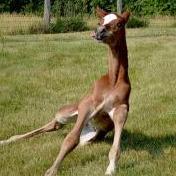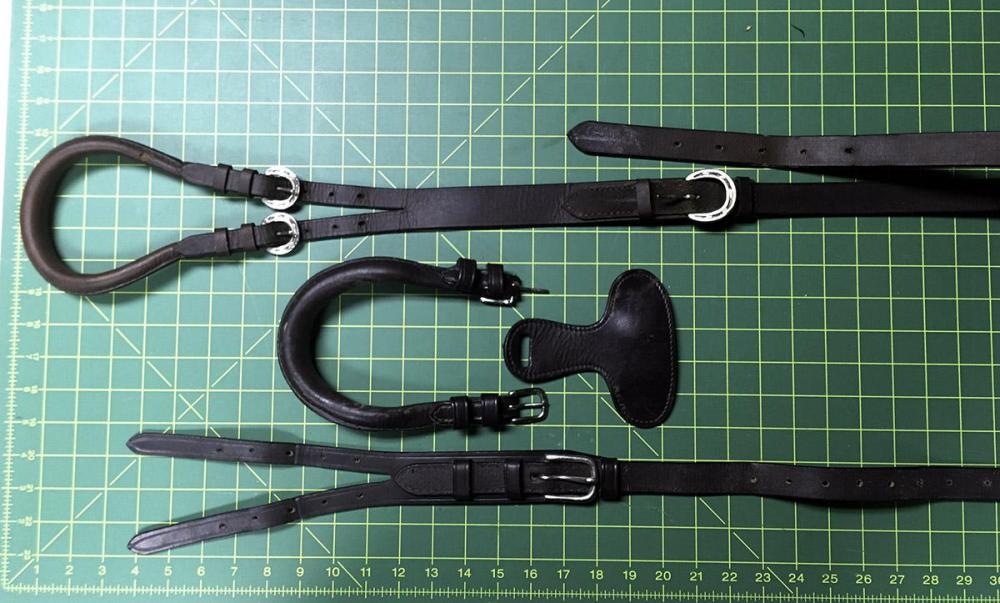-
Posts
1,270 -
Joined
-
Last visited
Content Type
Profiles
Forums
Events
Blogs
Gallery
Everything posted by TomE
-

7.5 in Ruger Super Redhawk 480
TomE replied to Hags's topic in Gun Holsters, Rifle Slings and Knife Sheathes
That's a handsome piece of work! If he runs out of bullets that gun will make a good club. -

Can a Pricking Iron be used as a Stitching Chisel?
TomE replied to DoItYourself's topic in Leather Tools
Maybe not just a legacy. I bought a new Vergez Blanchard pricking iron a few months ago that looked like a high school shop project. Stubby teeth with rough unfinished edges. Spent hours shaping, smoothing and polishing to make it useable. On the other hand, I am very happy with the Rocky Mountain European style pricking irons.- 5 replies
-
- pricking iron
- stitching chisel
-
(and 1 more)
Tagged with:
-
No pattern, but here are a couple of pony sized cruppers photographed on a 1 inch grid. The larger crupper at the top of the picture loops through a dee ring mounted on the cantle. The other crupper loops through a T-shaped tab that slips into the slot between the panel and flap underneath the cantle. The dock is constructed like a suitcase handle with a leather cover sewn around a flexible material (felt?). These cruppers have a 1 in buckle securing the point, and 5/8 in buckles for the dock. Steinke ("Bridlework") suggests making the dock from a piece of liner leather folded in thirds and sewn flat. His dimensions are Point: 22-28 in x 5/8 in. Buckle piece: 13 in x 1 in, tapering to 5/8 in where point and buckle attach. Splits: 8 in x 1/2 in. Dock: 11 in x 2 in, folded in thirds.
-
I appreciate and admire the work that goes into a pasture like that. Hope you're enjoying OK and the leathercraft.
-
-

Great West Saddlery identification help
TomE replied to Josier's topic in Saddle Identification, Restoration & Repair
Mike Graham, owner of Ruxton's Trading Post, is an expert in the history of western saddles. He has written books on the subject, and articles for Western Horseman. https://www.ruxtons.com/dynapage/PP03.htm -
A sharp awl gets my vote. Sewing with an awl is faster than pre-punching, and its more flexible wrt a wide range of thicknesses, odd shapes, and making adjustments on the fly. For fine stitching (~9 spi) I use the Rocky Mountain European style pricking irons to mark the holes instead of an overstitch wheel. I rarely use a 2-prong iron and instead tilt an 8-prong iron, tapping lightly to mark curved sections. I guess this wouldn't work well for driving a chisel home to punch holes.
-
That's some serious sewing through so many layers. Nice work! You're motivating me to work through my broken tack.
-
Stohlman's "The Art of Making Leather Cases" volume 2 covers several variations of this style handle (and many others).
-
Would not sharpen the inside of a punch tube --just remove any burrs. If you bevel the inside edge then the leather is compressed inside the tube and the punch is harder to use and doesn't clean out like it is designed to. Punch tubes don't need a fine edge, and it won't last as the tube presses into the copper anvil. Polishing the outside of the tube to remove paint and machining marks is the main thing. Can lightly dress the cutting surface of the tube (and the punch anvil) to create a flat edge before working on the outside of the tube.
-

Sharpening Round Knife Alternatives Good Enough?
TomE replied to AlamoJoe2002's topic in Sharpen it!
You can get a lot of experience sharpening a round knife if you start with an Osborne. I learned through trial and error that the key was to shape the blade with gradual taper before sharpening. Mine had a bull nose shape when new. I spent a lot of time working the taper with coarse stones. If you're smarter than me you'll find a friend with an abrasive belt to help you. -
I am grateful to the experts on this forum who have taken some of the mystery out of machine sewing. Thanks for sharing your knowledge and craft. Glad you're up and running again @Tequila. Happy sewing.
-

Replacing girth straps on jumping saddle
TomE replied to TomE's topic in General Saddlery Discussion
This was my first attempt to replace girth straps, and I followed Rob Steinke's instructions in "Repair Your Own Saddlery and Harness." Dropping the front of the panel was easy. Took a little fiddling to line up existing holes when sewing the panel back on. When I had trouble passing the needle and thread from the rear, I inserted a needle in the front (instead of an awl) to get things aligned before passing the needle and thread from the rear. The panel is fastened with an angled running stitch (pop stitching) that produces 1/4 inch long stitches spaced about 1 inch apart. Even with the panel dropped, there's little room around the stirrup bars so I was angling my needle when stitching near the top of the webs. Per recommendations, I stitched the girth straps to the web using a single needle backstitch, and overstitched the beginning and end of each line. I made girth straps from the butt of a Hermann Oak tooling side before learning about the rawhide and buffalo (bison) hide options available from Abbey England. Think my straps will be plenty strong for this pony saddle. -

First Bag I'm Proud of!
TomE replied to MtlBiker's topic in Purses, Wallets, Belts and Miscellaneous Pocket Items
That's a beauty! I like the colors. Nice workmanship. -
Biothane is a great product and used for quality tack. Although I make leather tack in my spare time we use a lot of biothane halters in the barns. If a bird craps on them I just toss them in a bucket and hang to dry. They are very durable and practical for daily use. Nonetheless, my time is better spent making and repairing leather tack.
-

Cobra 26 presser/walking foot marking up leather
TomE replied to AtomicLeathers's topic in Leather Sewing Machines
Just firm tapping. I usually just tap on the backside with the front facing the granite slab. It helps to smooth the stitch line and even out thread tension. The marks probably won't be removed completely, but it should help. A shorter/weaker spring is likely to be the best solution. -
Mike Graham, owner of Ruxton's Trading Post in Manitou Springs CO, is an expert on old saddles. He used to write a column for Western Horseman answering questions about vintage saddles.
-

Cobra 26 presser/walking foot marking up leather
TomE replied to AtomicLeathers's topic in Leather Sewing Machines
Do you tap the stitches down after sewing? I use a small hammer with a polished face and place the leather on a granite slab. I am sewing bridle leather, not harness leather, with a Class 4. The presser foot marks the leather when the thickness is > 20 oz. even with the tension setting at a minimum. Tapping the stitches helps, and the marks fade somewhat with time. -
Nice collection of brasses! This book from master saddler Robert Steinke's Ebay store is informative. https://www.ebay.com/itm/223744242608 If you buy from the author he will sign the book.
-
That's a handsome bag! Really like the handle and choice of leather. Old school is timeless.
-
I backstitch 3 stitches when sewing halters, whether by hand or by machine. When halters break (as they should if a horse pulls hard enough) it's usually the leather that tears at a turn or a hole in the crown piece.
-

Can you buy die cut leather like for strap attachments
TomE replied to MtlBiker's topic in Leatherwork Conversation
Sounds good. Look forward to seeing it. Stohlman describes a number of ways to attach handles and straps in volume 2 of his case making books. -

Can you buy die cut leather like for strap attachments
TomE replied to MtlBiker's topic in Leatherwork Conversation
Another idea is to change the construction and run the tab ends through an oblong (crew punch) hole and sew/rivet in place with a decorative stitch on the outside of the bag. Would use a plain strap from same leather as the bag. This construction is stronger than a surface mounted tab for the Dee ring. -
Stohlman's book on leathercraft tools explains how to use and sharpen these tools. One aspect of the choice is using a disposable blade versus spending time and money on sharpening equipment.
-
Osborne makes left and right handed versions. The thimble is covered with a metal honeycomb that holds the eye of the needle securely. https://www.cutexsewingsupplies.com/products/c-s-osborne-sewing-palm-266-rh-for-right-hand-made-in-usa?variant=32878000013365 The palm works pretty well but it's faster to grab a pair of pliers, which work in either hand.



